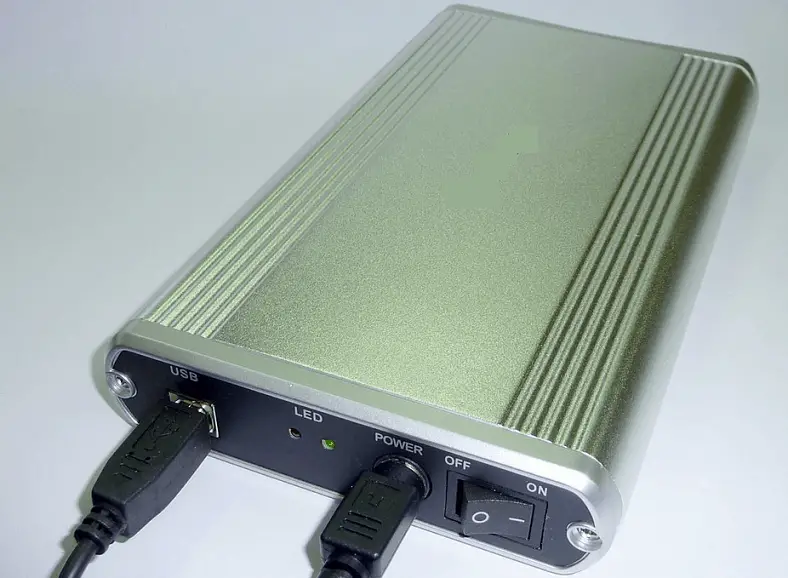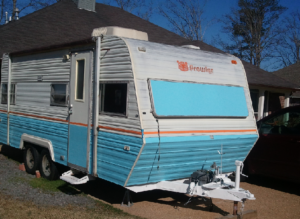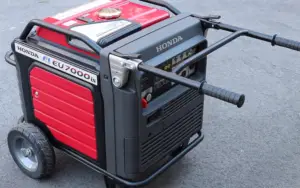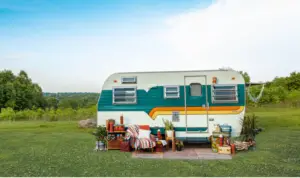Appliances in RV either run on DC supply (Direct Current) or AC Supply(Alternating Current). In case of DC, the current flows in one direction that provides constant voltage supply where as in AC, it changes directions periodically.
DC supply in RV comes from house batteries where as the AC supply comes from shore power through electrical hookup or from a generator. One more source of AC supply can be an inverter which converts the DC supply from battery into 120V AC supply.
The house batteries in RV can be connected in parallel or in series and based on the volts and number of batteries connected you will have either 6V,12 or 24 V. The AC supply is 120 Volts which is needed for bigger appliances.
So, what is the purpose of inverter in RV when you also have other power options.
Why is inverter needed in RV
An inverter in RV takes 12V DC input from a house battery and converts it into 120V AC. In absence of shore power or a generator, it can be used to power appliances in RV that need 120V AC supply for operation.
An RV just like your home is equipped with number of appliances that need 120V for operation apart from those that need 12V DC.
Larger appliances like Television, microwave, hair dryer, air conditioner need 120 Volts. Smaller appliances like roof vent fan, carbon monoxide detector run on 12V DC.
Some AC 120V running appliances like laptop computer are sensitive and need pure sine wave for operation otherwise they may get damaged.
Based on the output produced by the inverter, they can be classified as pure sine or modified sine wave. We will see about this later in this article.
An inverter can power almost anything that the shore power or generator can power. The only catch is, obviously how big the inverter is.
As you know the appliances are ratted for watts. The running watts can be higher as compared to the operating watts. Like, for example, an AC may need 1200 watts for operation but its starting watts requirement can be 1800 watts.
An inverter in RV can power any of the below appliances if it is rated for the watts needed.
- Air conditioner
- Television
- Microwave
- Hair dryer
- Laptop
- Water pump
These are just few examples. It can power almost all the appliances that run on AC supply.
Having said this, the total number of watts required at a time by the running appliances should not exceed the inverter capacity. Like for example, you may have AC running as well as microwave and the total watts may exceed the inverter watts, in this case the system will trip the fuse.
The whole watts consumption thing can be confusing. Lets see this later in the article in detail.
But, before that, lets see the diagram, setup and where the inverter would come into picture. We have seen the basics, now focus on how it is fitted inside your electrical system in the RV.
Working
In simple words, the inverter produces voltage supply similar to what you get from a shore power using the power stored in the DC house battery. Lets see the setup in a diagram below.

Here you can see that the battery in the RV produces 12 Volt which is not suitable for running bigger appliances like television or microwave. The inverter takes the DC 12V and processes it to give 120 Volts as the output.
The 120 Volt supply can then run the bigger appliances like TV or hair dryer. The output from the inverter can be pure sine wave or like a square wave which is also called as modified wave.
An inverter can power almost everything in RV that needs 120 Volts even an air conditioner. Air conditioner needs highest watts to start and operate as compared to other appliances in the RV.
An hair dryer or microwave also needs high watts but they operate for short duration. AC can run for 5-8 hours straight and that’s why the watts consumption by AC is a significant factor.
For RV, the inverter comes in different sizes ranging from 400 watts to 300 watts and even more. How big of a inverter you need will depend on the watts consumed by all the appliances running in parallel in the RV.
Here is a detailed electrical diagram that shows how an inverter comes into picture RV electrical setup.

The DC battery can be charged by the engine alternator to produce 12V DC supply. Battery can also be charged using solar panel kit or also through a generator. An inverter can also be used to charge the battery when it is not in use.
This diagram is still at high level, as there would be many other components that come into operation. Transfer switch for example, is missing here. Its an important component in case of inverter.
TS (Transfer Switch) basically acts a switch between the inverter and the shore power/generator power. When we have shore power the inverter is not needed and this switch does exactly the same thing. It connects either of these based on the availability of shore power. Whenever the shore power is not present, it would connect the inverter to supply the 120 V AC.
The transfer switch can be automatic or manual. In case of manual, you have to set it for correct power source and in case of automatic, it automatically switches from shore power to inverter whenever it is unavailable.
Installing an inverter is easy and it will be a single time effort. Once you hook up the inverter, you will either have an auto switch or a manual switch that will put the appliances on inverter supply whenever shore power is not present.
Comparing with generator
The difference between generator and inverter is the source used to produce the AC supply. While the inverter is fed with a constant DC supply, a generator needs fuel (Gasoline, diesel or propane) to produce the 120V AC supply.
Because a generator burns the fuel it makes noise while operating. Even it needs special starting procedure. In most generators, it wont be a simple switch press. You would need to pull a recoil cord and may sometimes have to try multiple times before it kicks off.
Inverter does not make noise apart from alarms that could be because of faults or issues. Switching power to inverter is also easier with a switch which can be manual or automatic.
Do you really need it?
If you often go RV camping without shore power or big generator and yet need the luxury of 120V AC supply operating bigger appliances then invest in an inverter. An inverter can also come handy during an urgency when you are stuck at a location with only DC battery as a power supply.
Having an inverter is always better if you are not sure whether you can have shore power or not. Especially, when you are out, traveling; inverter can provide the necessary power for your bigger appliances.
There are multiple other use cases where in inverter can save you from unforeseen situations. Lets see some of these scenarios.
No shore power and No generator
An inverter can use the battery alone to provide you the 120 V AC supply. With no shore power connection or generator, an inverter can turn out to be saver for you.
Some campgrounds do not provide shore power connection and if you are camping at such a place, then inverter can be a good green way to power your appliances.
Generator limitations
Having a generator is really great. In fact, before you have an inverter make sure you have a generator. However, there are some limitations with generators.
Noise
First, generator makes noise and you do not want to use it all the time. Like, for example, if you had to charge a computer or operate TV for some time, you may not want to run that noisy generator. An inverter is easy to operate and also, less hassle.
Fuel
Another thing could be, your generator may be low on fuel. In built generators use fuel from RV, and once it reaches 1/4th level, it shuts off the supply to the generator.
Also, generators do consume a lot of fuel. Whatever the case, inverter will come handy with a battery alone as the power source.
Transportation issues
Carrying generator can also be an issue. If you own a travel trailer then you need to mount the generator safely, probably above propane tanks. They are heavier, take up space and also need specials arrangements. Inverter on the other hand are smaller and compact like a small box. This makes them great for usability and transportation.
Running hours at campground
Some campgrounds have limitations on generator running hours. This is done for various reasons like keep noise levels low, reduce emissions and it also keeps your neighbors less disturbed.
This however may not be good for you if the campground does not have shore connection. You will be forced to return from site seeing to the campground just to use the generator. Not unless you had the inverter though.
When you are stuck with no other option
This can happen to anyone. Unexpected things happen when things don’t work as expected.
A bad weather, unplanned visits or locations specific issues can result in you being stuck at a location with no other power source. During such times inverter can come really handy.
Dry camping or boondocking at a remote location may not always turn out to be what you had expected. A night without fuel for generator or other issues with generator can force you to spend the night without power unless you had the inverter with you.
Inverter already installed in RV
Some RV’s come equipped with inverter and that is when you wont need to install another one. Many RV’s have this as an optional add on.
If you bought a used RV and need to know if the RV has an inverter or not, just check the manual. You will find all the details about inverter in the RV manual. Also, you can always confirm this with the previous owner.
If you want to figure out this on your own then just turn off the engine, shore power and try running the appliances like radio or TV, they should work if the inverter is installed else they wont start.
Deciding on the Size
So, you are convinced that an inverter can be a great investment and now you are ready to get one for your camper. But, before you pick one be sure to decide on the size, that is the watts.
An inverter is rated for watts which it can generate. So, lets check out the ideal size of an inverter for your RV.
Size of an inverter that you should get for your RV will depend on the number of watts required to operate the appliances at a time. Practically, you should go for at least 10-20% above the total watts you would need.
If you want to have an inverter as an emergency source then go for something that would run all the appliances you feel are required during emergency. You can get an inverter right from 400 watts to more than 3000 watts.
So, how many watts you need for your RV appliances? This is nothing but the total number of watts needed by all the appliances that would run parallelly. There could be an AC running along with a refrigerator and others.
Each of these appliances have running and starting watts. Starting watts are mostly higher than the operating watts. Here are some average watts consumption examples, to give you some hints.
- Microwave : 600-700 watts
- Refrigerator : 500 watts
- TV : 50-80 watts
- Lights : Based on watts (20-100 watts)
- Mobile charging : 20 watts
- Computer laptop : 100-120 watts
- DVD : 30 watts
The watts consumption will vary based on different factors and hence the total consumption can also vary. Therefore, you need to do an audit to figure out how many watts it can be in total. Based on this, you need to decide on the watts for the inverter.
For example, your consumption could be around 1200 watts. When this is the case don’t go for exact 1200 watts but instead go for 1500 watts or higher to be on the safer side.
Battery size
Getting an inverter alone may not do the job. The main point here is the source supply, which is DC battery. If you need to run the appliances for more duration or want to run bigger high consuming appliances then your batteries also need to be big enough.
You have to increase the battery bank if you want to employ a higher watts inverter. Inverter can drain the batteries if the appliances are consuming high watts. Check here how long your battery can last while the inverter is running.
Type of Inverters
Before you buy an inverter its very important that you know the different types. Otherwise, you may end up buying one that will be totally useless for your RV.
There are two types of inverters, first is a pure sine wave and the second, modified wave inverter.
The main difference between these two is the output wave that they produce. A pure sine wave tries to copy what you get through a shore power. Its a smooth sine wave that is mostly suited for sensitive appliances like laptop or television.
Because they produce pure sine wave, they are also costly. If you want to run LED TV or CFL bulbs then be sure you get a pure sine wave inverter only.
Modified wave inverter output is not a pure sine wave instead it is created by multiple steps which will not be suitable for appliances that are sensitive.
These type of inverters are cheap and therefore, be careful when you pick an inverter. Do not buy a modified wave inverter just because it is cheap. You may end up damaging your costly appliances. These type of inverters can be used for running tools that will run fine with such modified supply.
Pure sine wave inverters are becoming less expensive as the technology is advancing.
Cost
Cost of a RV inverter depends on the watts. You can buy a 1000 watts to 2000 watts inverter at a cost of around $200 to $450. Higher the watts, higher will be the price.
Other questions
Should i leave my inverter on all the time?
Keeping an inverter ON all the time will keep the power continuity even when the shore power is lost. Your RV batteries will drain upto certain level after which they will be recharged.
Does a inverter uses power even when no appliances is running?
Like most other equipment, inverter also uses some power even when no appliance is operating through its power supply. This consumption is however minor and shouldn’t bother you much. Also, the batteries will recharge when they fall below certain level.
Conclusion
An inverter is definitely a good investment for your RV specially when you travel a lot or if you are full timing. Its a perfect compliment to your other power sources like generator, battery and solar panel kits.





